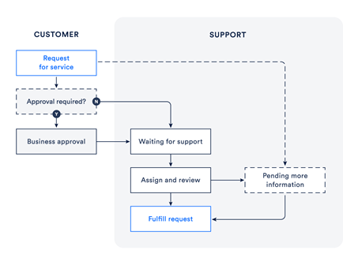Atlassian defines IT service management as “how teams manage the end-to-end delivery of IT services to customers.” From design to support, all aspects of ITSM should level down to being considered as a service.
Along with Atlassian, we believe teams come first. Why does this matter to ITSM? IT teams are the core and backbone necessary to enable productivity and digital transformation that can improve all teams. Without valuing and motivating these teams to make a difference in the organization’s everyday processes, there is little to no room for organizational growth or improvement. There is more reason ITSM is important to organizations, so let’s dive in.
In this article we will discuss:
Why ITSM Matters
Although a lot of importance ITSM has to an organization lies within improving the principles of service management, it actually instills significant structure and provides multiple benefits to other areas of the organization, such as raised efficiency and productivity levels, aligned business goals and standardized service delivery. Most importantly, strong ITSM procedures incorporated into an organization increase customer satisfaction.
Atlassian has an ongoing list of further ITSM benefits, but here are a few E7 believes stand out the most (and can save your organization on costs):
- Success metrics that measure the alignment of business priorities with IT teams
- Sharing the knowledge of IT teams with other teams to forward overall advancement
- Offering self-service or other quicker support services to further customer experience
ITSM Management Processes
The evident reality of technology’s endless advancements in today’s world provides a lot of room for improvement across all sectors of an organization. From tearing down traditional processes to upgrading to more modernized procedures, consistency, efficiency and stronger productivity are a few aspects that modern IT teams can experience with the resources available now. The major ITSM processes can be found and described below:
 Service Request Management
Service Request Management
This ITSM process is pretty straightforward on the surface. Put simply, the way this ITSM process works is a request submittal being entered for a new service or information and that request is then sent into the request fulfillment process. This is where the customer’s service request is put through all the stages by your organization, starting with responding to the request to finding out how to resolve the request while maintaining maximum support levels and quality for the customer.
Knowledge Management
There is much that can be and is learned by all team members that can help others within an organization. Implementing an effective way to store helpful information is summed by the term knowledge management. It is crucial to incorporate continuous learning among all teams, as knowledge is one of the most useful and available tools.
IT Asset Management
Organization is a key component of keeping an organization running smoothly and efficiently. By applying IT asset management, assets can be accounted for, deployed, maintained, upgraded and eventually disposed of. It may be discovered that some assets were not being used to the full potential, and some may be useless clutter than can be removed or is no longer useful to the organization. Either way, implementing this process makes it easier to level out the values and tangibility of items.
Incident Management
Incidents are always going to occur and disrupt service from time to time. Unfortunately but realistically, no system, equipment or technology is built to lifelong perfection. However, developing a process where incidents can be responded to by teams in an effective and organization manner is where incident management comes into play and makes dealing with incidents less overwhelming for your organization and your customers affected by them. This process is important to apply to organizations because it may just save over $300,000 – while in their course, that is how much some large incidents cost each hour. Below are some benefits of incident management we place a narrow focus on:
- Reduced costs from lost time or revenue for the result of incidents on organizations
- Improved ability to measure incident resolution
- Stronger communication while incident is in motion, creating less chaos
- Stored information that can be used effectively for future incidents
 Problem Management
Problem Management
Another core process within these ITSM frameworks is problem management: a process in which the causes of incidents on IT services are identified and managed. The misconception of simply finding the reason why a problem occurred reducing the chances of it happening again is not how this ITSM process works. The underlying factors as well as the steps that took place resulting in an incident is what needs to discovered, unfolded, observed and dissected to reduce the chances of its reoccurrence.
Change Management
Change is the ultimate driver for growth in many instances, specifically when it comes to business and competition. This ITSM process, change management, is essential to implement within an organization as it involves limiting or preventing as much disruption to customers’ access and response capability to IT services as possible. It can be tricky to work on systems and services that are critical as the chance of causing an interruption is always possible, but it is also critical to engage in practices that can prevent the likelihood of incidents. There are two major practices of change management in relation with ITSM, which are IT change management (now referred to as “change control”) and organizational change management.
Enterprise Service Management
A lead up from general IT service management is enterprise service management. This process represents a binding of the effective use of IT teams and services to other areas of the organization, such as marketing, finance or HR. One of the most rewarding aspects that we find when helping customers maximize the use of Atlassian tools is how many ways it can improve both the inner and outer workings and functions of an organization.
ITSM Tools
 As mentioned above, all things ITSM should be considered as a service. That's why there is such a narrow focus on the service portal, which is one of the most important tools that can be used as an interface for connection between IT teams and customers. Today, the fast moving pace of technology and its impact on leading industries is putting more depth and weight on ITSM tools to be faster, always available and provide ample and stellar customer experience.
As mentioned above, all things ITSM should be considered as a service. That's why there is such a narrow focus on the service portal, which is one of the most important tools that can be used as an interface for connection between IT teams and customers. Today, the fast moving pace of technology and its impact on leading industries is putting more depth and weight on ITSM tools to be faster, always available and provide ample and stellar customer experience.
In order to stay up-to-date with the rapid evolution of technology today, ITSM is the heart of where your organization should look to accomplish that. No longer is IT service management solely about support, it's about ample and available service as well as being an ultimate provider for your customers. This is where Service Management can accelerate your business and empower teams to support your organization whole-scale, from IT to HR.
If your organization is in need of implementing an effective Incident Management process or other support on ITSM, we're your team! At E7 we offer Journey to JSM packages which are designed to get your team into JSM with all the guesswork removed. Our out-of-the-box packages include strategic guidance, design workshops, assessments and recommendations, implementation, and training. More than a proof of concept, you'll have our expert analysis, scorecards to measure continued success, and a fully realized service management solution!
Stop wasting valuable resources with your service management systems and start your Journey to JSM today with E7 Solutions.






.png?width=300&height=115&name=New%20Project%20(1).png)

